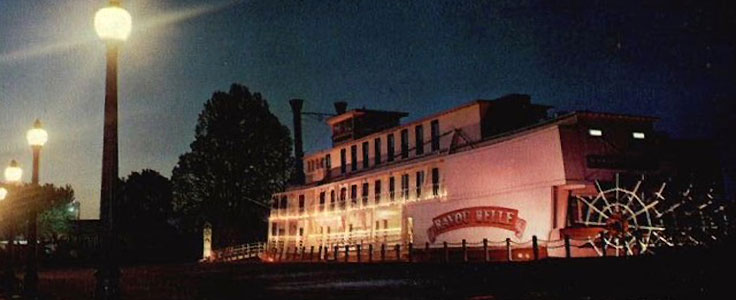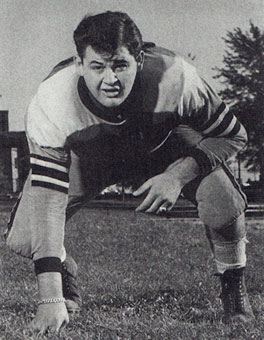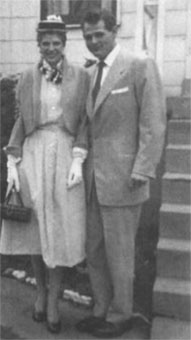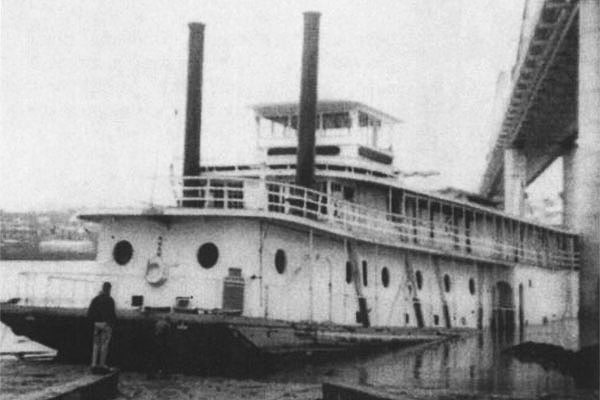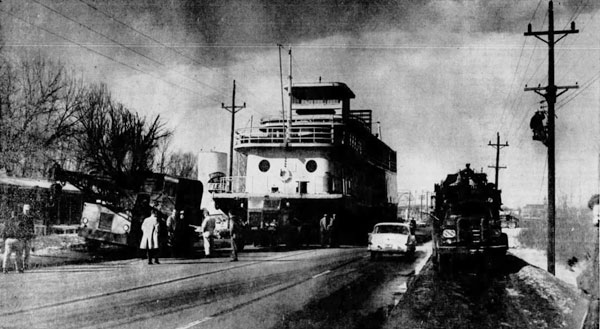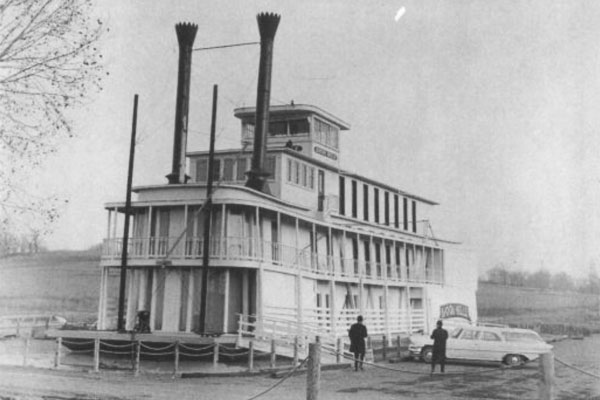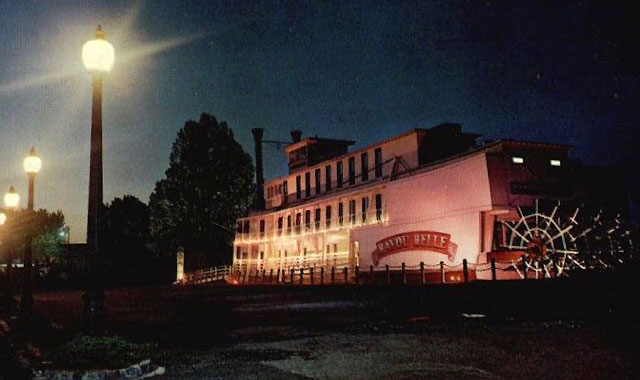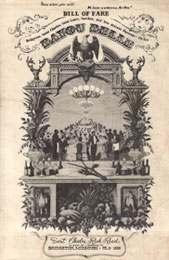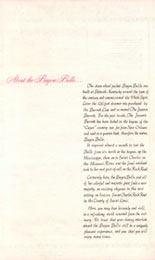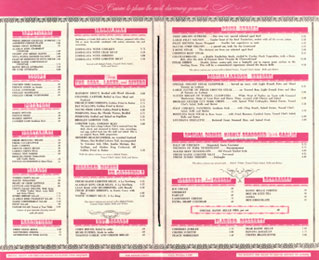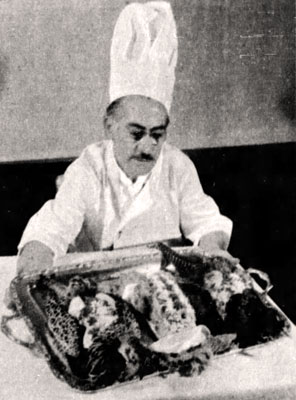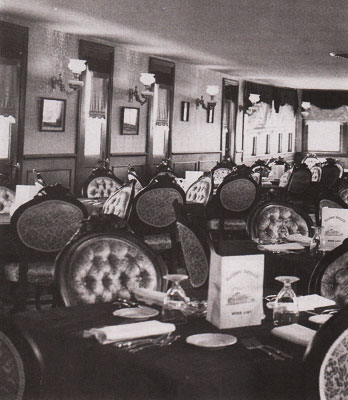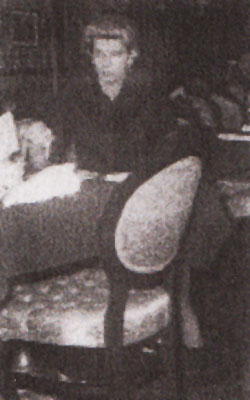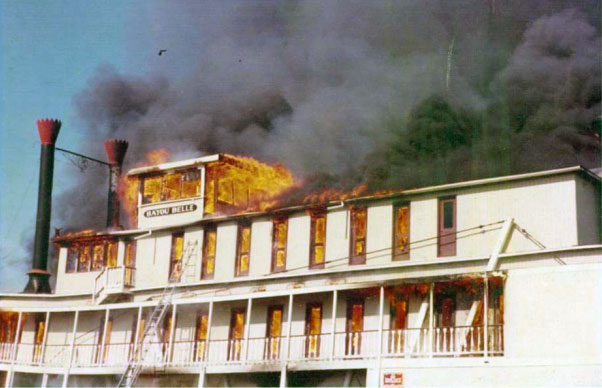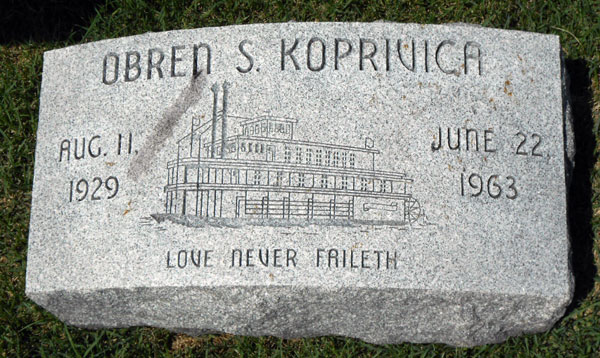|
Bayou Belle Obren "Obie" Koprivica was a football hero at University City High School. The caption under his yearbook picture read, "Everyone knows Obie. He's a BIG man."
Jean Prehn went to Normandy High School. She
had intended to be an art teacher, but she met and fell passionately
in love with Obie Koprivica in college. The two left college and
were married soon after.
Koprivica worked at various jobs after college, but none suited him. His family had owned a number of restaurants while he was growing up, and his dream was to open a restaurant of his own. Koprivica had honeymooned in New Orleans. He had fallen in love with the city and wanted to bring New Orleans to St. Louis. He decided on a riverboat restaurant and convinced Gene Alexander, a friend whose family was also in the restaurant business, to be his partner. Riverboat restaurants docked on the St. Louis levee were subject to the whims of Mother Nature. Koprivica wanted a restaurant with year-round access. His steamboat restaurant would be dry docked in the middle of a concrete moat, safe from flooding or sinking or wrenching loose from its mooring and drifting away. In September of 1961, Koprivica learned that an older couple with a farm in Bridgeton might be willing to sell off a portion of their land. Part of their farm lay along St. Charles Rock Road, just east of McKelvey. At the end of September, Koprivica gave Frank and Elsie Bienker a check for $500 to secure a lease for the property, with an option to buy. During the same period, Koprivica went to New Orleans to look at a steamboat owned by a Pentecostal church. The Jeanne Barrett was located in the swampy waterways of the bayou. Its interior had been stripped and the engine taken out, but its wooden hull was sound, as were all decks and stairs. And the paddle wheel was still in place and functional. A sternwheeler packet, the 126-foot boat had been built in Paducah, Kentucky in 1891, and commissioned the White Spot. Later, as a ship of the Barrett Steamship Line, it was named to honor a female of the linage. The church had used the steamboat as a meeting place. Koprivica and Gene Alexander bought the Jeanne Barrett for $8000. They needed two towing companies to get the boat to the St. Charles Rock Road bridge, near the land they had purchased. One would take the long haul up the Mississippi to its confluence with the Missouri. The second would do the short haul to the highway bridge. Then a house mover turned boat mover would load up the Jeanne Barrett and haul it overland.
The towers delivered the boat to the designated
bridge on October 21, 1961, exactly three weeks after hookup. Before
the move could proceed on its final overland leg, the tall smoke
stacks were taken off to reduce utility line clearance. The
paddle wheel was also taken off to avoid damage.
While the Jeanne Barrett was being transported, Koprivica found a chef for his restaurant. Salvatore Cappiello was 70-years-old and had retired a half dozen times. Together they planned a menu that would offer prime steaks, seafood and flaming desserts, with a New Orleans influence of gumbos and jambalaya. The Jeanne Barrett, renamed the Bayou Belle by its new owners, finally arrived at its new home at 12241 St. Charles Rock Road. The Belle was eased into the long concrete mote that had been laid while it was being moved. The moat, spanned by a fancy gangplank, would not be filled with water until just before the restaurant opened.
Renovation began in the spring of 1962. Initial
plans had the Belle opening by fall, but the fire marshal stepped in
and declared that the wooden walls did not meet code. The wooden hull had to be altered with fireproof
materials.
The Belle was decorated as authentically as
possible. The traditional riverboat colors of deep red, gold and
white predominated. The elegant main dining room had maroon and red
brocade chairs, with gold thread. Luxurious floor-length red velvet
drapes, with gold cords and tassels, lined the walls.
On the evening of June 22, Obie Koprivica returned to the Belle after supper to finish painting one of the smokestacks. The area was small and accessible from the roof of the second deck. While painting, he stepped back from the smokestack and fell off the roof, plunging head-first into the empty concrete moat. He was taken to St. Louis County Hospital with a massive brain injury. He died the following morning.
Koprivica's wife Jean decided to complete the
renovation of the Belle and open the restaurant as planned. On
Saturday night, September 15, 1963, the Bayou Belle's bar was opened. The cocktail waitresses wore red
satin outfits trimmed with black. There was a ragtime trio of two
banjo players and a base fiddle that played old riverfront tunes.
The cover of the Bayou Belle's menu had been
reproduced from an original riverboat menu. Inside, lightly screened
in pink, was a riverfront scene with packet boats, cotton bails,
lumber, drays, buggies and levee hands. The bill of fare was inserted
inside, with the offerings that Obie Koprivica and Salvatore Cappiello had
planned. The menu included Steak Obren, a double loin steak that was
butterfly cut, broiled and topped with a Cajun sauce.
Long before the Bayou Belle opened, Salvatore Cappiello
had hired Michael Surrisi, an
experienced chef in his own right, to be his head man in the
kitchen. Within a few weeks of opening, the 72-year-old Cappiello
announced he would retire yet again. The change of leadership was
handled without a glitch.
The whole operation ran smoothly. The bar was always full. On most week nights, only the main dining room was used, but there were usually two fairly full seatings. On weekends, the third deck was open to regular diners and often hosted private parties. Monsanto staged a tribute on the Belle to its longtime chairman Edgar Queeny. It renamed the boat the "Queeny Belle" for the evening. Anheuser Busch had a private party on board the steamboat to introduce Michelob in bottles.
The Bayou Belle became the destination of
choice for after-prom parties. In April and May, the boat hosted
grand southern galas on Friday and Saturday nights, filled with
young belles and gentlemen.
On October 15, 1964, Jean Koprivica sold her half interest in the Boyou Belle to her partner Gene Alexander for $75,000. The restaurant continued on successfully under Alexander's ownership and management. By 1975, the old riverboat was flanked by fast-food restaurants and a shopping center. At 3:05 p.m. on Sunday, October 5, 1975, an alarm was received by the Bridgeton fire department. By the time they arrived at the Belle, it was burning out of control.
An investigation was undertaken to determine if
arson was responsible for the destruction of the Bayou Belle
restaurant. The investigation was inconclusive.
In February of 1964, the headstone had been set at Obie Koprivica's
grave. At his wife's request, the monument company had etched a
silhouette of the Bayou Belle onto the stone. His dream of a
steamboat restaurant had been realized, and both dreamer and dream
were together memorialized.
Works cited: Surrisi, Jean. The Bayou Belle, Memories and Recipes. West Pine Publishing, 2001.
Copyright © 2018 LostTables.com |

